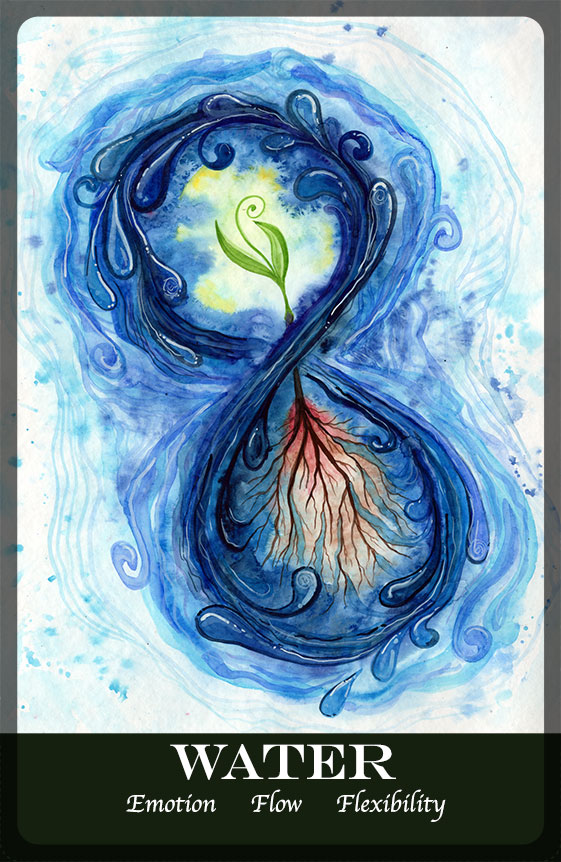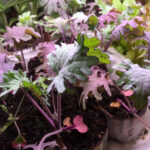Intentions are powerful things. They allow us to shape our force of will and set a path forward. They help us figure out what our own goals are. And I think because of that, we often see them as very personal. This is something that we do for our own purposes. In many western occult traditions, and even in druidry, intentions are often framed as highly internal things: things we set, things we want to manifest, things that help us shape our vision. You’ll see this very frequently in any ritual work–set your intentions for a ritual, a creation, a space, a new piece of land, and so forth. I think a lot of this is influenced by western occultism, which unfortunately puts the practitioner in a place of power and at the center of a working. I also think a lot of this is culturally influenced–westerners are inherently individualistic and self-focused, and this individual focus is both subconscious and conscious. This self-focus is an enormous problem when it comes to building reciprocal relationships with nature. Westerners also have a view of the land that implies ownership–ownership of lands gives full rights to do anything you want with it. Thus, it’s hard to say you are respecting the agency of the land and her spirits when you pretty much go in and do whatever you want to the land at any time.
I wanted to share an alternative approach that I’ve done with our land here, a way of moving me out of the center of my own intentions and instead considering intentions as a mutual and shared thing that I create in relationship with the living earth (for more on reciprocity and nature, see this post). If we open up our intentions and let the spirits of nature be co-creators in shaping intention, it can lead to some amazing results and allow us to cultivate reciprocal relationships with nature.
Reciprocation and Intention
I’ve been arguing that reciprocation should be a core value that we build into nature-based spiritual traditions. It is through reciprocation that we can build a stronger nature-based spiritual tradition, that we can work to repair the wrongs of previous generations (particularly those in relation to lands and indigenous peoples), that we can work to reverse colonialization, and that we can build a better future for all life on earth. It is through reciprocation that we can begin to understand that humans are not above nature but are part of nature. Reciprocation is also built into the Ancient Order of Druids in America (see our vision statement, here), the order where I am currently serving as Grand Archdruid.
I think that reframing intentions as something that can be reciprocal can move us a few steps in the right direction, both through our magical practices and our intentions for the living earth.
Intentions are the spark of an idea; they are an early commitment to moving in a particular direction, and they are often the beginning of a magical, spiritual, and/or physical practice (or something of all three). So now let’s look at two ways we might shift intentions to a more reciprocal relationship.
Preliminaries: Nature Communication
In order to do any of the work I’m suggesting below, you will need ways of communicating with the spirits of nature and the land around you. If you’ve been on a nature-based spiritual path or practice any kind of deep nature awareness, you probably don’t need anything I’m going to say and can skip this. But if you are newer to this or unsure, I wanted to give you some options and resources.
- Gut feelings and intuition. A lot of nature communication is based in feeling and understanding the signals that our body tells us. In other words, when you walk into a forest, how do you feel? Do you feel welcome? Do you feel unwelcome and like the forest doesn’t want you there? Those initial gut feelings are a critical part of communicating with nature–particularly in listening.
- Divination. Divination tools such as ogham, tarot, pendulum, geomancy, etc. are great ways of communicating with the spirits of nature and are particularly useful for those who are still developing other methods of spirit communication. For setting intentions, I recommend that you use something very simple that has a yes/no function, thus, a pendulum is most appropriate (things like tarot or ogham get more complicated in their interpretation, where a pendulum will be very direct). To use a pendulum in this way, I would suggest creating one with something from nature (a stone from the land around you and a string). Then simply ask it to “show me yes” and “show me no” and now you know how to interpret it.
- Spirit communication. More advanced practitioners can develop more direct ways of communicating with spirit through their inner vision: visuals, conversation, sensing energy, etc. This method is what you will want to work up to–being able to converse with a tree, for example, allows things to be quite clear. I have a series on how to cultivate plant spirit communication, so please check out these posts for more information: part I, part II, part III, and part IV.
The only other preliminary thing I suggest you do is to prepare some kind of offering for your work with the spirits of the land. I’ve written more on offerings here, here, and here.
Setting Intentions for a Space or Project

Let’s say you have land and you want to create a new project on that land. It might be a sacred grove, a druid’s anchor spot, or a sacred garden. Here’s another great opportunity to set intentions collaboratively. As one of the first things you do, reach out to the land
I would suggest that this should not be a one-time practice but rather a practice that is done on a regular basis. The practice is simple: go to the spot and simply say, “I’d like to set shared intentions for [this space, the project, etc].” Then have a conversation, use divination, or any other means to set those intentions. It may take some time as nature often works on a different timeline than we do. But this work will unfold and you’ll see how rich the collaborative intention setting can be.
Intentions in my druid’s anchor spot. In one example, I’ve found that my druid’s anchor spot likes to set new intentions with each season, so I make it a point to do that work at the solstices and equinoxes. Usually, at the Winter Solstice, the intention is simply “rest” but in the other seasons, we set intentions together for the work to come. These intentions can vary pretty widely: last year in the fall, the shared intention was to share a story of the day, and as it grew dark, each of us would tell a story and listen to each other’s story. The year before, the land was very intent on having some of the biodiversity returned, so we worked together on various approaches to bringing in biodiversity (specifically through cleaning up certain areas that had garbage, bringing in new soil, and planting new trees, understory, and woodland medicinal species). I am excited to see what this season’s intentions will be!
Intentions for the earth oven project. In a second example, I’ll share how to set intentions for a project. The Druids Garden homestead is a 5-acre homestead in Western Pennsylvania, run by two druids. We spend a lot of time prior to engaging in any project setting intentions with the land in collaborative ways. On a larger scale, this includes figuring out what parts of the land want to be wild, which want cultivation, and where we can create gardens and more human-tended spaces (in permauclture terms, this is about setting up our zones of use, among other things).
Thus, when I decided to build the earth oven, I sat with the land over a period of months and asked, where can I build this oven? Once both my partner and I had a clear sense of where to build, I began to narrow down the spot to the specific work at hand. I was given permission to create a small path about 15′ into the brush and to create my oven there. I was also shown a clear space for a shrine that would sit on the path to the oven. I explained to the land that this would require me to move/cut some plants and remove the topsoil, and the land told me that I could ask each individual plant what to do (compost, replant, pot up and give away) as well as any stones in the area. So I began that work–it took me a few sessions, but it was very rewarding. Some of the plants wanted to be harvested and made into medicine (blackberry roots). Others were rhizomatic (like mayapple), and wanted to simply be composted. The small cherry tree (also abundant) wanted to be made into pendants and gifts. The wild yams wanted to be replanted and showed me where. Spicebush wanted to be potted up and given to a specific person. The fledgling sassafras made it clear that she was the boundary and that I needed to situate the oven in a way that did not disturb her growth. By the time I had “cleared” the land, every specific plant and tree that was there had the opportunity to state their intentions, and those intentions were honored. After that, I could begin building the earth oven knowing that the land was fully honored and included in the intention of that space, and because of it, we would be able to work deep magic with the oven in the years to come.
Now imagine the difference in this experience if I had just come into the land, started pulling up plants, piling them up, and then clearing the land. The end result–a physical space for an earth oven would have been the same. But my own relationship with the land would have suffered; the land being a victim at my hands. Thus, when I talk about reciprocation, this is exactly what I mean. We include the land, we not only as permission but we ask what we should do, how we should do it. I think that its important to recognize that the land loves us, and wants to help us meet our goals. This reciprocation puts nature in equal partnership with us, and the blessings flow from that relationship.
Setting Intentions for a Magical Working, Ceremony or Ritual

Perhaps the most common means through which people set intentions are at the start of magical working, ceremony, or ritual. I would say that co-setting intentions for rituals really depends on what the ritual is for–for yourself, for the living earth, for something else? Whoever is involved should be involved in setting the intentions for the ceremony.
If it is a ritual that is primarily focused on you and on something tied to yourself, I would still suggest connecting with the spirits of nature for their guidance and wisdom. Here’s a simple approach: anytime before you begin the ritual, take a short walk in nature. Find a place to sit (such as your druid’s anchor spot), and describe to the spirits of nature what you are planning on doing. After you share, make an offering and see if they have any guidance.
If the ritual is on behalf of the living earth or tied to the land in any way, you need to take whatever time you need to set intentions in a collaborative way with the living earth. This is not always a simple process and may take quite a bit of time. Begin this with a conversation that is open to the spirits of nature. Rather than saying, “I want to do this ritual,” instead, go to nature and simply say, “What do you need?” “How can I support you?” and see what comes from that conversation. Don’t assume you know what the spirits of the land want and need, but rather, allow the spirits of nature to collaborate with you to co-create the ritual. You can also reach out and say, “I’d like to offer a healing ritual for the land. Do you think that would be a good idea?” The point here is that if you go in telling the land what you are already planning on doing, that’s not very reciprocal. Rather, create space for a conversation and a shared vision to come forth.
You can do this essentially on any level–individual, group, or even with a larger group. Here’s a recent example of a larger group practice that we recently completed. A few years ago, AODA had released our Vision Statement, and it became clear to some of us n leadership that we wanted to do something order-wide that was reciprocal with the land. Individual members already do a lot in our curriculum in terms of tree planting, earth path lifestyle changes, and so forth. But we wanted something that was community-based. And so, a few of us began speaking with the lands around us. What could AODA do, on an order-wide level, that would support the living earth where we lived? What would the land need? Through our own work over the next six months, a very clear picture emerged of what we, as an order could do–a summer solstice land blessing and a winter solstice waterway blessing using AODA’s frameworks (here they are if you are interested!) These rituals were not just created by humans in AODA, but rather, in conjunction with meditations and collaboration with the lands around us. I’m really excited that these rituals will be starting this year in 2022, and you are most welcome to join us in this endeavor!
In these examples, we can again see how setting intentions–magical and mundane–in conjunction with the living earth allows us to reciprocate and collaborate in ways that we cannot do if we only set intentions within ourselves. I hope you found this post useful and inspiring. I would also love to hear from readers about how you may already set intentions in co-created ways with the living earth!




Reblogged this on Paths I Walk.
Lovely post. It came after I began the day reading from The Yoga of Herbs by Dr. Vasant Lad. The chapter that explains the manifestation of consciousness into plants. So much similar in thought and beauty.
Thanks Julia!
I’m 80 years old. My husband is 82. I spend a lot of my time tending his needs, which is exactly what I want to be doing.
But I’ve also been engaging in healthy ecological efforts for years. Our house sits on 2 acres in a water-deprived area. We’re fortunate to have irrigation but due to area growth, it is in constant jeopardy. We consider some agriculture venture that will justify our current level of irrigation. “Progress” in this area is injurious to the environment, already stressed because of profiteering logging interests—people who feed their children by cutting down trees are possessive of the “right” to that destruction and that is fed by logging companies who make millions. I’m now engaged in irrigation efforts that will satisfy the water authorities (should such a thing be possible!).
Pertinent to this post, I’ve been developing an area of an Anchor Spot in our yard. We’re fortunate to have a small wild area in the back of the property, trees (grove?), and native plants and fauna. Deer visit us regularly—and, predictably eat my plants! Birds abound. And digging animals aggravate. I continue to attempt to redirect these destructive little neighbors!
But the thing I have *not* done, as you suggest in this blog, is to interact with the property on its wishes. I’m told by old timers that this used to be a dairy pasture, but I don’t know if the land ever welcomed that. So I intend to continue my development of my anchor spot and to sit out there in the dawning to try to hear my land speak its wishes.
I have your book as well as the Druidry Handbook and read both, along with other texts to develop a strong bond with Mother Earth.
Many blessings for your teaching and efforts.
Hello AlmiraMay, I’m glad that this post has helped you consider a new way to deepen your relationship with your local land. I would love to hear what your land shares with you, and what new directions that might take you in. Blessings to you! 🙂
[…] Intent for Autumnal Equinox weekend; can refer here: Druidry for the 21st Century: Setting and Co-Creating Intentions with Nature – The Druids Gard… and for rest of year 2024: Daily Rituals: Core Practices for Druids – The Druids […]
[…] Intent for Autumnal Equinox weekend; can refer here: Druidry for the 21st Century: Setting and Co-Creating Intentions with Nature – The Druids Gard… and for rest of year 2024: Daily Rituals: Core Practices for Druids – The Druids […]